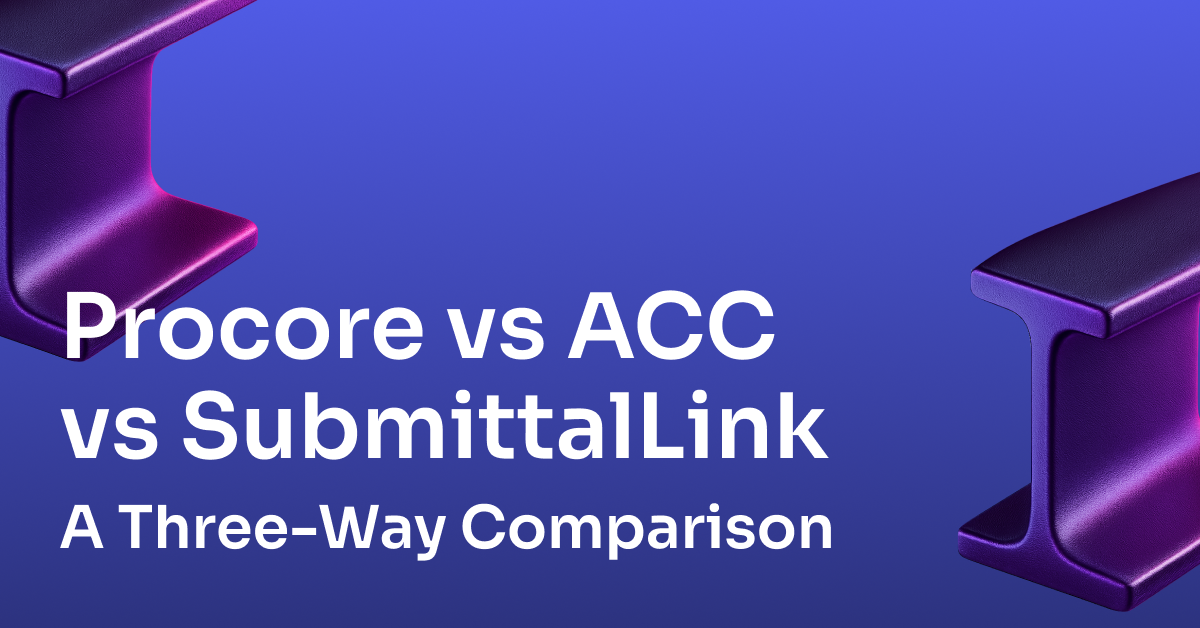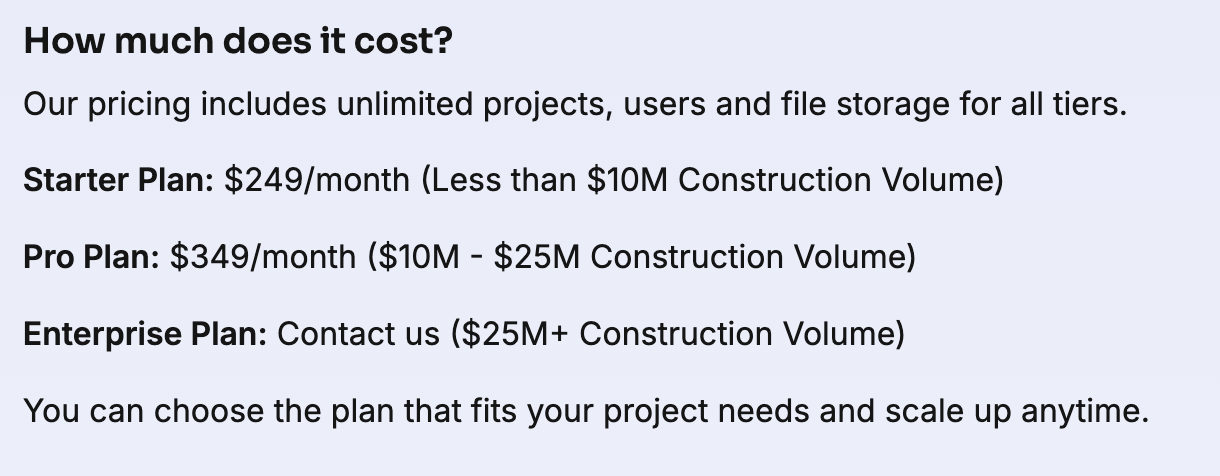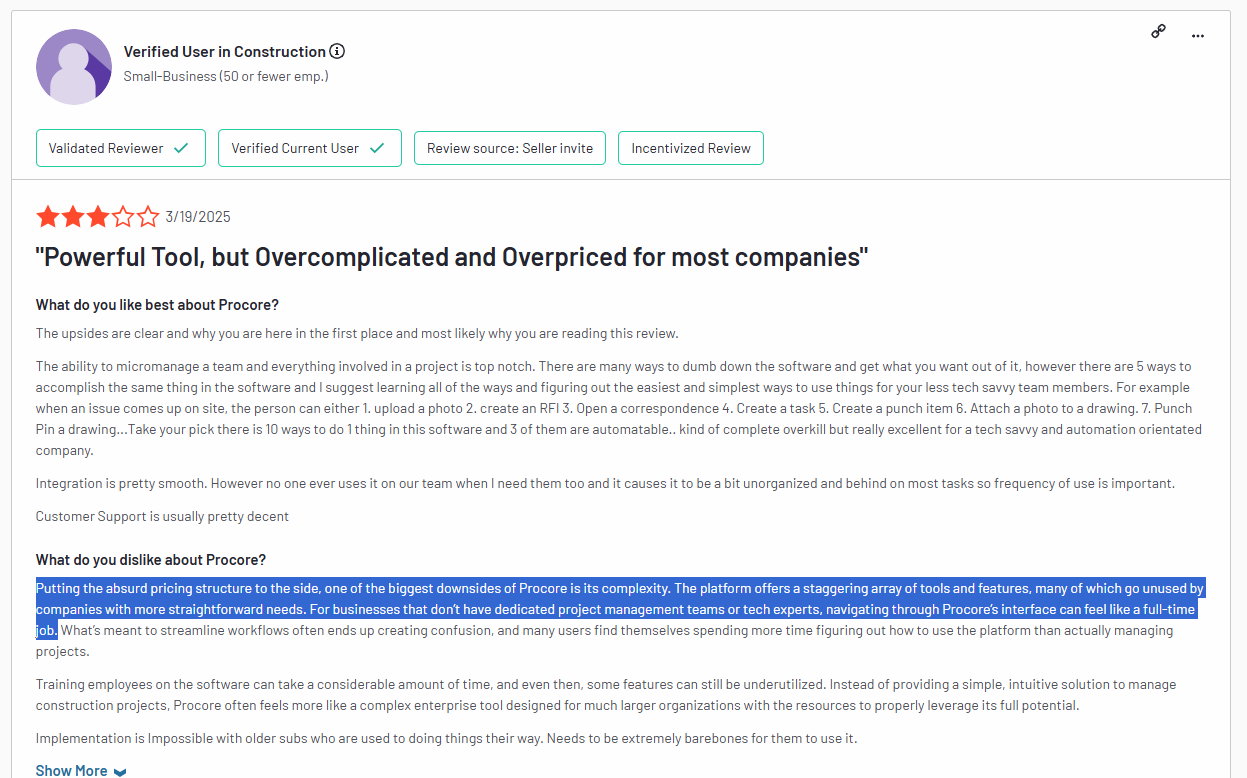Procore vs ACC vs SubmittalLink: A Three-Way Comparison

Introduction
Today’s construction projects often depend on software to manage documents, schedules, and collaboration. When contractors search for Procore competitors, they usually compare Procore with Autodesk Construction Cloud (ACC) and SubmittalLink. Procore and ACC are leading all-in-one solutions, while SubmittalLink offers a leaner alternative focused on essentials like submittals, RFIs, and drawings (and a daily reports, change orders, contracts, and punchlists).
Each platform has its niche: Procore is the enterprise heavyweight with extensive modules for large teams; ACC excels for companies using Autodesk’s design tools and BIM workflows; SubmittalLink streamlines the core features most teams actually use. Many contractors find Procore and ACC powerful but costly and slow to learn, often paying for modules they rarely touch. SubmittalLink’s approach is to keep submittals, RFIs, drawings, daily reports, contracts, change orders and punch lists, making it faster to adopt and more cost-effective for local builders.
TL;DR – Which is Best for Who? (Quick takeaways)
If you’re researching Procore competitors or looking for the best Procore alternatives, here’s how the leading options compare:
- ✅ Procore – Best for large companies with complex projects. As the industry standard, it’s the go-to choice for enterprise-scale GCs and project owners who need a very broad toolset. Works well if you have the budget, in-house IT support, a dedicated APM or Project Engineer to manage a complex platform.
- ✅ Autodesk Construction Cloud (ACC) – Strongest competitor for teams deep in the Autodesk ecosystem. If your workflows revolve around AutoCAD, Revit, or BIM coordination, ACC integrates seamlessly with those tools. Ideal for design-build firms and BIM-heavy projects.
- ✅ SubmittalLink – A faster, simpler Procore alternative designed for local builders and mid-sized contractors. Focuses on the core tools: submittals, RFIs and drawings (and a few more including daily reports, punchlists, contracts and change orders), without overcomplicating things. Affordable pricing and minimal learning curve make it a top choice for teams that want efficiency without extra complexity.

What Procore and ACC Have in Common
Procore and Autodesk Construction Cloud (ACC) are robust platforms built for large-scale projects, sharing several strengths:
- ✅ Centralized Project Hub: Both provide a single location for drawings, documents, and updates, keeping office and field teams aligned.
- ✅ Mobile Field Access: Their apps let crews view plans, file reports, and handle RFIs or punch items from tablets or phones, with changes synced to the main system.
- ✅ Workflow Automation: Built-in tools streamline submittals, RFIs, and punch lists, replacing spreadsheets and email threads with structured forms and automatic notifications.
These advantages come with common drawbacks:
- ⚠️ Steep Learning Curve: Rich feature sets mean significant training is often needed, and many teams appoint a dedicated tech lead.
- ⚠️ High Costs for Smaller Firms: Pricing can reach tens of thousands annually, which is difficult to justify for local builders using only a fraction of the tools.
- ⚠️ Unused Features: Many pay for modules they never use like safety, incidents, or forecasting when their needs center on submittals, RFIs, and drawings.
In focus, ACC excels at Autodesk design integrations (Revit and AutoCAD), while Procore offers a broad third-party app marketplace for flexibility. Neither is quick to self-onboard, both require formal training leaving room for simpler options like SubmittalLink, which delivers only the essentials without the high cost or complexity.
Platforms Comparison Table
Platform Summaries
Let’s dive into each platform’s key features, and who benefits most (or least) from each:
Procore
Procore is widely seen as the enterprise standard for construction project management, offering an end-to-end platform covering bidding, drawings, RFIs, submittals, scheduling, budgeting, and accounting integrations. On large, complex jobs with hundreds of submittals and RFIs, it replaces dozens of spreadsheets and endless emails with a centralized system. Many major general contractors and construction managers use it as their project information hub.
Best Fit:
- Large GCs, CMs, and Developers running multi-million or billion-dollar projects with complex documentation, multiple stakeholders, and strict workflows.
- Firms with Dedicated IT/Admin Support who can train staff and manage the platform’s depth.
- Teams Seeking All-in-One Integration to consolidate field reporting, contracts, and change management, with access to 300+ marketplace integrations.
Less Ideal For:
- Local Builders who may not need costly modules like Financials or Safety and find the learning curve steep without a dedicated admin.
- Teams Lacking Training Time without full adoption, Procore’s benefits are less effective.
- Budget-Conscious Owners who can’t justify paying a percentage of project costs when margins are tight.
Autodesk Construction Cloud (ACC)
Summary: ACC is Autodesk’s all-in-one ecosystem for BIM-heavy and design-driven projects, uniting tools like Autodesk Build, BIM 360, and Revit into a single platform. It bridges the gap between the design studio and the jobsite, keeping Revit models, AutoCAD drawings, and field issues in one connected cloud workspace. For projects where 3D modeling and plan coordination are central, ACC delivers strong integration and collaboration.
Who Should Use ACC:
- Design-Build & BIM Teams: Ideal for projects with complex models and constant architect–contractor coordination. Supports model markups, clash detection, and linking RFIs/issues to specific locations.
- Autodesk Users: Fits seamlessly for teams already using Revit, AutoCAD, or Civil 3D, often with bundle pricing for AEC Collection subscribers.
- Large Projects Needing Full Lifecycle Tracking: Connects design, construction, and handover phases with standardized workflows and enterprise-grade security.
Who Might Not Benefit:
- Non-BIM Workflows: If you work mainly in 2D without model coordination, ACC’s BIM features may go unused.
- Teams Needing Simplicity: Its wide capabilities come with a learning curve, which can feel heavy for smaller subcontractors or straightforward projects.
- Cost-Sensitive Firms: Pricing is more predictable than Procore but still significant, especially if advanced features aren’t fully utilized.
SubmittalLink
Summary: SubmittalLink is streamlined construction submittal software built around the tools project teams actually use: submittals, RFIs, drawings, and punch lists; all in one fast, easy-to-use hub. Powered by Microsoft Azure for speed and reliability, its clean interface and quick load times keep things simple, without the clutter of unnecessary modules. Every customer gets a dedicated U.S.-based onboarding and support contact, offering a personal touch larger platforms often lack.
Who Should Use SubmittalLink:
- Local Builders & GCs: Ideal for $1M–$50M projects where Procore or Autodesk Construction Cloud feels like overkill. A great fit for teams upgrading from email or spreadsheets to purpose-built submittal software without the complexity of enterprise systems.
- Teams Needing Fast Rollout: Projects can be set up and running in a single day, with no long implementation process or heavy training. The system feels familiar to anyone used to Excel or older systems, but adds the efficiency of modern construction submittal software automation.
- Builders Who Want “Just What We Need”: Designed for crews that need to manage submittals, RFIs, and drawings and nothing more, keeping it straightforward for project managers, engineers, and superintendents.
Who Might Not Benefit:
- Enterprise Firms with Complex Integrations: Large companies needing deep customization or proprietary system integrations may find its scope too narrow.
Teams Seeking a Full All-in-One Platform: If you want everything from bidding, scheduling, budgeting to accounting, under one roof, a broader platform like Procore or Autodesk may be a better fit.
Read more here:
Pricing Comparison
Cost is often the deciding factor when choosing between Procore, ACC, and SubmittalLink.
- Procore: Pricing is opaque and based on either total construction volume or project value, often around 0.1%–0.2% of project cost. That means a $20M job could run $20k–$40k in annual fees. Packages bundle multiple modules, so smaller teams may pay for tools they don’t use. Renewal increases and upsells are common, making budgeting tricky.
Read more here: Procore Pricing

- Autodesk Construction Cloud (ACC): ACC charges per user or project, usually in the hundreds per seat annually (e.g., Autodesk Build around $800/year). Costs are more predictable than Procore’s percentage model, but bundles can still include tools you don’t need. For some teams, ACC can be cheaper than Procore, but it depends on team size, scope and usage.
- SubmittalLink: Uses transparent, fixed monthly pricing with unlimited projects and users. All features are included, no upsells or hidden fees. Plans start at $150 per month, making it far more affordable than Procore’s six-figure contracts for many small and mid-sized contractors.

(Note: All pricing examples here are anecdotal and for comparison only – for the most accurate, up-to-date quotes, you should contact Procore or Autodesk, as their pricing in 2025 can vary widely by company and usage.)
Customer Feedback Snapshot
What are real users saying about each platform? Here’s a quick snapshot of common feedback themes, pulled from user reviews and discussions (G2, Reddit, etc.):
- Procore – “Powerful but heavy.” Users almost universally acknowledge that Procore is feature-rich and a very powerful tool for managing construction projects. Many appreciate how much it can do – you’ll hear things like “it’s great to have everything in one place.” However, there are consistent gripes about the usability and cost. Reviews often mention the steep learning curve and that some smaller teams never fully utilize all the features. A comment on Reddit summarized it as: “everyone loves Procore… the only criticism is that it’s hard to learn and expensive” (source: reddit.com). Additionally, some Procore users complain about paying for modules they don’t need, as noted earlier. Support experiences are mixed. For some, Procore’s support is helpful, but others have described getting bounced around between support reps without quick resolutions. On the positive side, Procore has a large user community and knowledge base, so often you can find answers or best practices from peers.

- Autodesk Construction Cloud – “Great for BIM, can be overkill.” Fans of ACC and its components (Autodesk Build, BIM 360, etc.) often highlight how valuable it is for coordinating models and drawings in one platform. A common refrain is that if you’re using Revit or other Autodesk products, ACC becomes a natural extension of your workflow. People love not having to double-handle data – design issues can become construction issues in the same system, for instance. That said, some feedback from smaller contractors who have tried ACC is that it feels geared for larger projects. They cite that the interface isn’t as straightforward for basic project management needs if you strip away the BIM elements. In essence, ACC can feel “cluttered for a small job” or require too many steps for something like a simple RFI if you’re not utilizing the more advanced capabilities. Cost doesn’t come up as negatively as with Procore, but users do mention that you should only invest in ACC if you plan to leverage its full integration power – otherwise, you might be just as happy with a simpler, cheaper tool.
- SubmittalLink – “Just what we need.” When contractors and project managers look for Procore competitors, SubmittalLink often comes up as a lean, focused alternative. As a newer, niche platform, its feedback comes directly from its customer base of builders and PMs who were seeking an alternative to the big, all-in-one platforms like Procore and Autodesk Construction Cloud. The recurring theme in reviews is that SubmittalLink is easy to use and covers the essentials. A common sentiment is: “We were paying a fortune for other software but only using a small portion of it – SubmittalLink focuses on the fundamentals and does them better.” Clients appreciate that they’re not paying for or wasting time on modules their small team doesn’t need. Speed is another big win. Actions like uploading a submittal or generating a report happen quickly, without the lag that some users report from larger systems. And the support? It gets consistently high marks, users value having a dedicated rep who knows their account, instead of navigating generic support channels. Many reviews note that SubmittalLink helped their teams get a handle on submittals and RFIs without a steep learning curve, exactly what most contractors want from Procore competitors. While some users mention they’d like to see more integrations in the future (such as with scheduling or procurement tools), the overall sentiment is clear: SubmittalLink delivers on its promise of a fast, lean solution for managing construction submittals.

FAQ
Q: Is Procore more expensive than ACC?
Often, yes. Especially on large projects but it depends. Procore’s custom pricing (usually a percentage of project volume or a flat annual fee) can climb quickly, while Autodesk Construction Cloud (ACC) generally uses per-user or per-project subscriptions. For similar scopes, Procore can cost more unless negotiated well. Existing Autodesk users may get ACC bundled at a better rate. Factor in hidden costs like training time, not just subscription fees, and always compare quotes side-by-side.
Q: Which platform is easier for submittals and RFIs?
For pure simplicity, SubmittalLink wins. It’s purpose-built for submittals and RFIs, letting you create, attach, and send in just a few clicks. Procore and ACC handle these workflows well but come with more setup steps, permissions, and fields to manage. ACC integrates tightly with documents and models, while Procore offers deep project structure but both require more learning. If you want speed and minimal overhead, SubmittalLink is the most straightforward.
Q: What’s the fastest way to get started on a project?
SubmittalLink can be running the same day with minimal learning curve and instant usability. Procore and ACC are powerful but slower to launch, with onboarding, configuration, and training often taking weeks. If your project starts soon and time is critical, SubmittalLink offers the quickest path from sign-up to action.
Final Thoughts
Choosing between Procore, Autodesk Construction Cloud (ACC), and SubmittalLink depends on your team’s size, workflow, and budget. All aim to streamline project management and cut paperwork, but their approaches differ.
For large, complex operations with the budget and time for full implementation, Procore or ACC can deliver robust, all-in-one capabilities. Procore is a versatile, enterprise-grade tool trusted by big builders, while ACC offers similar scope with the bonus of deep Autodesk and BIM integration.
Smaller or fast-moving teams may find more value in SubmittalLink’s focused approach. It avoids overcomplication and cost, letting you handle submittals, RFIs, and logs without unused extras. Some contractors even mix platforms using Procore when required by an owner, but SubmittalLink for leaner projects.
The best platform is the one your team will actually use consistently. Whether you choose a comprehensive suite or a streamlined tool, moving away from paper and Excel is a win for construction efficiency.
Disclaimer: This comparison is based on publicly available information, user reviews, and our experience as of August 2025. It is intended to provide a general overview – always do your own research and get up-to-date info directly from the vendors before making a decision. All opinions expressed regarding Procore and ACC are those of the authors (from a SubmittalLink perspective) and may not reflect the official views of Procore or Autodesk. Pricing anecdotes are for illustration; actual quotes will vary. All product names and trademarks are the property of their respective owners.
